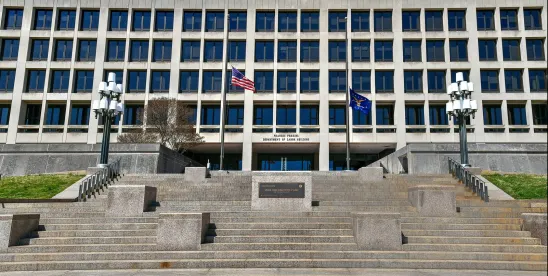The election is over and a second Trump administration will begin in January 2025 (“Trump Administration”). Numerous changes to the employment law landscape will come with it. And if past is prologue, many of these changes will roll back various Biden-era initiatives and priorities at the various federal agencies tasked with implementing and administering federal law governing the employer/employee relationship. Below is a summary of just some of the changes employers could expect at the Equal Employment Opportunity Commission (“EEOC” or “Commission”), Department of Labor (“DOL”), and National Labor Relations Board (“NLRB”) during the Trump Administration, as well as what employers could expect to see with respect to the federal government’s efforts to prohibit certain restrictive covenants.
The EEOC
The forthcoming Trump Administration undoubtedly means changes at the EEOC. The most significant changes to the Commission will likely be delayed until 2026 due to the current Democratic majority. Nevertheless, the new administration is likely to adopt a more conservative stance on diversity, equity, and inclusion (“DEI”) initiatives, and revise—or outright reverse—Biden-era policies and priorities aimed at strengthening protections for LGBTQ+ and pregnant workers.
A second Trump Administration will likely challenge employer DEI practices in employment. This aligns with Trump’s earlier efforts to scale back DEI efforts, including attempts to ban racial sensitivity training for federal contractors. Recent Supreme Court decisions, including overturning affirmative action, likely signal a renewed focus on how federal agencies interpret civil rights and anti-discrimination laws. And, with respect to interpreting anti-discrimination statutes, a more conservative Supreme Court is likely to align with more a conservative EEOC.
The Trump Administration may also seek to limit the scope of protections afforded to employees under the Pregnant Workers Fairness Act (“PWFA”). As a reminder, the PWFA requires that eligible employers provide reasonable accommodations to a qualified employee’s or applicant’s known limitations related to, affected by, or arising out of pregnancy, childbirth, or related medical conditions—unless the accommodation would cause the employer an undue hardship. Andrea Lucas, the sole Republican appointee is widely thought to be President-elect Trump’s nomination to chair the Commission and has publicly voiced more conservative stances on employment issues. For example, Lucas previously criticized the EEOC’s broad interpretation of the PWFA, which includes accommodations for abortion and conditions like menopause and infertility. Following the Supreme Court’s decision in Dobbs v. Jackson Women’s Health Org. (overturning Roe v. Wade), Lucas initiated commissioner charges against companies offering abortion travel benefits—ostensibly on the basis that such benefits might constitute discrimination against pregnant workers who choose to carry pregnancies to term.
Finally, the Trump Administration may attempt to roll back protections for LGBTQ+ workers. Earlier this year, the EEOC revised its workplace harassment guidelines for the first time since 1999, broadening the definition of sex-based discrimination. This now encompasses actions such as the repeated and intentional use of a name or pronoun inconsistent with the individual’s known gender identity (misgendering), or denying an individual access to a bathroom consistent with their gender identity. Lucas publicly opposed that updated guidance—contending the guidelines might infringe on employees’ right to religious freedom or expression.
In sum, while changes to policies and priorities of the Commission under a second Trump Administration may take time, they are undoubtedly coming. Employers should therefore work without outside counsel to monitor developments at the EEOC.
The DOL
Employers should expect significant changes at the DOL during a second Trump Administration. In all likelihood, the “new” Trump DOL will look much like the old—prioritizing more employer-friendly policies while rolling back Biden-era regulations and recommendations.
For starters, President-elect Trump has consistently vowed to reinstate “Schedule F”—a 2020 executive order that would reclassify thousands of federal workers as “at-will” employees. If implemented, many have speculated this would result in a significant reduction in staff at the DOL and other federal agencies. Significant reductions in agency staff could have sweeping implications for regulatory or enforcement actions and priorities across the board.
A key element of President-elect Trump’s campaign was immigration reform and, more particularly, deportation of undocumented persons. Accordingly, a Trump DOL could potentially collaborate with other federal agencies on undocumented workers. This could result in worksite raids and heightened scrutiny on—and requirements for—employment eligibility.
Almost certainly, a second Trump Administration will make it easier to reclassify workers as independent contractors. Recall that shortly before President Biden was inaugurated, then-President Trump’s DOL finalized easing the necessary requirements to classify workers as independent contractors. But the Biden administration never implemented the rule and, accordingly, it never went into effect. In all likelihood, President Trump’s DOL will reinstate the proposed rule and make it easier for persons to be classified as independent contractors.
A second Trump DOL may also try to roll back Biden-era rules and regulations concerning overtime pay. In 2019, the Trump administration implemented a rule that increased the salary threshold for overtime eligibility to $35,568 annually. President Biden’s administration greatly expanded the salary requirement—which will hit $58,656 on January 1, 2025. Many expect a new Trump Administration to reassess and roll back the heightened overtime threshold, at least partially. Importantly, however, the updated salary baseline will take effect weeks before President Trump is inaugurated. To that end, any rollback will require significant administrative effort and regulatory procedures. Employers should therefore not expect any Trump Administration changes to the new overtime rules to take effect immediately.
The NLRB
As we saw in 2008, 2016, and (as we outlined here) 2020, when a Presidential election results in a change from one political party to the other, it likewise brings both immediate and long-term changes to the labor law landscape. Employers should anticipate another similar paradigm shift under a new Trump Administration, starting with the likely removal of Board General Counsel (GC) Jennifer Abruzzo. Since GC Abruzzo took over for GC Peter Robb in 2020, following then-President Biden’s unprecedented removal of GC Robb shortly after President Biden’s Inauguration, GC Abruzzo has drastically altered the prosecutorial priorities of the Board’s various regional offices through the issuance of various GC Memoranda. These GC Memoranda have identified numerous Board precedents that GC Abruzzo deemed worthy of reversing under a largely expansive (and oftentimes novel) view of the National Labor Relations Act. As previously covered, GC Abruzzo’s August 2021 agenda memo largely signaled the very changes we have seen over the course of the past 3 plus years.
Immediate Change for Agency’s Top Prosecutor
A new NLRB GC will likely rescind various memos issued by GC Abruzzo. Although we expect any newly-appointed GC to rescind scores of currently-active memorandums issued by GC Abruzzo, a sampling of the memos that are likely facing rescission include the following:
- GC Memo 24-04, which greatly expanded the scope of consequential damages Regions should seek in unfair labor practice proceedings;
- GC Memo 21-07, addressed here, which instructed Regions to seek no less than 100 percent of the backpay and benefits owed in cases that are settled, and, in cases where a discharged employee waived reinstatement to his or her former position, required Regions to include front pay as part of any settlement;
- As we outlined here, GC Memo 23-02 set forth the GC’s recommendation to the Board to find that an employer’s use of surveillance practices that interferes with or prevents a reasonable employee from engaging in protected activity creates a rebuttable presumption that the employer has violated Section 8(a)(1), unless the employer can demonstrate that the practices at issue are narrowly tailored to address a legitimate business need. In such cases, even where the employer is able to demonstrate that its claimed business need for the surveillance practice outweighs employees’ Section 7 rights, the GC urged the Board to require employers to disclose to employees the technologies it uses to monitor and manage them, the reasons for doing so, and how the information obtained is being used, unless the employer demonstrates that special circumstances require covert use of the technologies;
- As we covered here, GC Memo 22-04, which outlined GC Abruzzo’s intent to ask the Board to reconsider a well-settled, decades-old precedent, which has long permitted employers to hold mandatory “captive audience” meetings to educate employees, share views on unionization, and discuss what employees’ rights are with respect to the same; and
- More recently, GC Abruzzo issued GC Memo 25-01, arguing certain “stay-or-pay” provisions are unlawful under the NLRA as part of her earlier initiative declaring certain non-competes and restrictive covenants unlawful (which we covered here). Memo 25-01 goes even further and calls for employers to go beyond mere rescission of the non-compete provision and directs regions to seek traditional make-whole remedies for unlawful provisions consistent with Board law. Unless rescinded by a newly appointed GC, employers have through Dec. 6, 2024, to cure any existing stay-or-pay provisions that advance a legitimate business interest.
Expected Change in Board Composition Over the Next Year
In addition to an expected GC change, the Trump Administration will likely work to alter the Board’s composition to shift it to a Republican majority. While the current Board has a 2-1 Democratic majority (and Board Chair Lauren McFerran (whose term expires on Dec. 16, 2024) is awaiting a vote to be confirmed to a third term, along with Biden’s package nomination of Joseph L. Ditelberg to fill the Board’s vacant Republican seat), the Senate has not yet acted on these nominations. While it is possible McFerran could be confirmed for a third term (thereby leaving the Board with a Democratic majority until at least August 2026, when Democratic Member David Prouty’s term expires), it appears unlikely these nominees will be confirmed by the Senate prior to Trump taking office. Should these seats remain unfilled through Inauguration Day, they will likely be filled by Trump appointees and the Board will return to a Republican majority – likely at some point in 2025 – thereby paving the way for pro-employer decisions.
Likely Changes Through Board Decisions During Trump Administration
Election and Related Demand for Recognition Procedures
As we outlined here, on August 25, 2023, the Board, through its decision in Cemex Const. Materials Pac. LLC, 372 NLRB No. 310 (Aug 25, 2023), created a new standard that essentially revived the dormant Joy Silk Mills doctrine with some modifications, thereby allowing unions to achieve recognition as the certified bargaining representative of employees without requiring a formal NLRB secret-ballot election. A Trump GC would likely cease pursuing cases under this standard and a newly-composed Board should be expected to overturn this decision relatively soon after reaching a republican majority.
Standard for Assessing Legality of Workplace Rules
Regarding employer work rules, a Trump Board will likely return to the more consistent, employer-friendly Boeing standard by overturning the Biden Board’s decision in Stericycle Inc., 372 NLRB No. 113 (2023), which decision we previously covered here. The Stericycle standard applies to union and non-union workplaces and goes far further than simply overruling cases decided during the Trump administration. Under this standard, a work rule is presumptively unlawful if it has a reasonable tendency to chill employees from exercising their rights when viewed from the perspective of the reasonable employee, even if a contrary interpretation of the rule is also reasonable. Once established, the employer must prove that 1) the rule advances a legitimate and substantial business interest, and 2) that the employer is unable to advance that interest with a more narrowly tailored rule.
On the other hand, the Boeing standard, which is anticipated to return under the Trump Administration, classified company rules into three categories:
- Rules that are lawful to maintain under the NLRA;
- Rules that warrant individualized scrutiny; and
- Rules that are unlawful and the adverse impact on NLRA rights is not outweighed by justifications associated with the rule.
Following many years of increasing volatility (both under the Obama and Biden Boards), the standard established in Boeing gave employers a level of stability and predictability in their ability to maintain discipline and productivity in the workplace.
Independent Contractor Test
The Trump Board will likely return to the standard set forth by the Trump Board’s 2019 decision in SuperShuttle DFW, Inc., 367 NLRB No. 75 (2019), which established a test for determining if an individual is an independent contractor, as discussed here. A return to the SuperShuttle standard would result in a Board focused on a worker’s “entrepreneurial opportunity” as an animating principle to determine independent contractor status, instead of equally evaluating all of the common-law factors (which, as applied by the current Board, has made it extremely difficult for employers to contest employee status).
Issuance of Various Rules Impacting Election Processing
In addition to pursuing various doctrinal shifts via Board decisions (which require appropriate cases to work their way to the Board), a newly-seated Trump Board will likely contemplate issuing a notice of proposed rulemaking that will seek to (a) reverse the “quickie election” rules, introduced by the Biden Board, that set very tight timelines on hearing dates and elections, promoting election speed over resolution of various legal challenges brought by employers; (b) as outlined here, reverse the Biden Board’s Fair Choice – Employee Voice Final Rule (“Final Rule”), which has altered the Board’s blocking charge policy and permits regional directors to delay representation and decertification elections upon a filing and resolution of an unfair labor practice charge upon request by the party who filed the ULP; (c) reverse the Biden Board’s return to an immediate voluntary recognition bar, since the current Final Rule removes the 45-day window so employees will no longer be able to request an election to challenge an employer’s recent voluntary recognition of a union; and (d) revisit the Final Rule’s directive that makes it easier for construction industry unions to become the exclusive bargaining representative for construction employees based only on contractual language.
Retreat from Gerrymandered Bargaining Units
As we covered here, the Biden Board (through its decision in American Steel Construction, Inc., 372 NLRB No. 23 (2022)) had reinstated the Obama-era Board’s 2011decision in Specialty Healthcare and Rehabilitation, 357 NLRB 934 (2011), establishing that a bargaining unit was appropriate if the petitioned-for unit was “readily identifiable” as a group and shared a community of interest. This standard essentially allowed unions to set the scope of the bargaining unit unless the employer could show that an “overwhelming community of interest” existed between the selected unit and the excluded employees. We expect a Republican-majority Trump Board to once again reverse Specialty Healthcare and return to a traditional community of interest test for determining the appropriateness of a bargaining unit, as it had previously done in PCC Structurals, Inc., 365 NLRB No. 160 (2017) and The Boeing Company, 368 NLRB No. 67 (2019) (decisions collectively referred to as the “PCC-Boeing” standard).
The above likely represents only a fraction of the changes at the NLRB that employers should expect in the coming four years.
What About Noncompetes?
It is unlikely the incoming Trump Administration will make the prohibition of restrictive covenants a priority. While the Trump campaign has largely stayed away from the topic, leading Republican lawmakers widely oppose such rules and regulations as “anti-business,” a sentiment echoed by pro-business groups such as the Chamber of Commerce. We will likely see the trend of states passing their own legislation prohibiting restrictive covenants—either generally or limited to certain industries, such as healthcare providers—continue. These state laws are being passed not only in historically red states but blue states as well. See, for example, here and here.
Currently, the FTC rule prohibiting noncompetes remains ensnared in litigation. Based upon the Trump campaign’s position regarding restrictive covenants, it is unlikely his administration will seek to defend the rule in court. The lead champion of the rule is current FTC Chair Lina Khan, whose term as Chair expired on September 25 but continues to serve as Chair until a successor is appointed. We expect the Trump Administration to replace Ms. Khan with someone it deems more “business friendly” and who likely will cause the Department of Justice to abandon its defense of the rule. Should that occur, the rule would, for all intents and purposes, be null and void, and there would no longer be any federal ban on restrictive covenants.
Conclusion
As identified above, we anticipate that there will be numerous changes to the employment law landscape with the incoming Trump Administration.
Additional Author: Jonathan Clark







 />i
/>i

